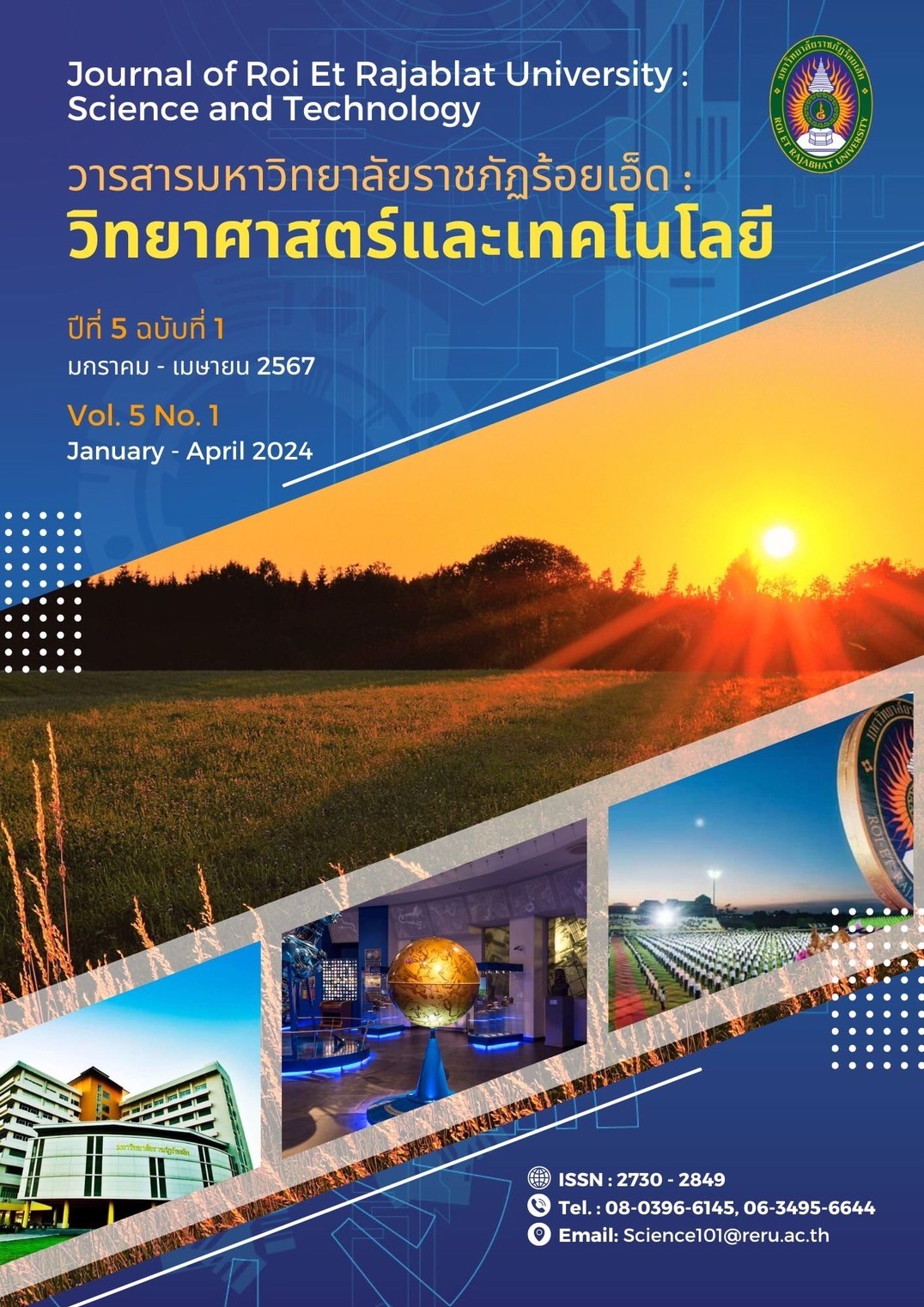Use of Cannabaceae Residue as Alternative in Controlling Aedes aegypti Mosquito Larvae
Keywords:
Cannabaceae residue extract, Aedes aegypti larvae, toxicity testAbstract
Aedes aegypti is the primary vector of dengue fever, which has been a significant public health issue in Thailand from the past to the present. There are initiatives to use plant-derived compounds as an alternative to manage mosquito vectors. The objective of this study was to examine the effects of hexane and methanol crude extracts from cannabis residues on Aedes aegypti larvae in the third and fourth instars at different concentrations (0, 125, 250, 500, and 1,000 mg/L), and mortality at 24 was observed. It was revealed that Cannabaceae residue hexane extract exhibited the highest larval mortality (98.00%) with median lethal concentrations to kill 50% (LC50) of the treated larvae in 24 hour of 13.120 mg/L. Meanwhile, Cannabaceae residue methanolic extract displayed 88.00% larval mortality with LC50 of the treated larvae in 24 h of 67.059 mg/L. There was no significant difference in the mean total mortality of Ae. aegypti between the two solvents (p ≥ 0.05). Consequently, crude extracts of Cannabaceae residue would be used in the future to control Ae. aegypti larvae and other insects of medicinal and veterinary interest in risk regions.
References
Abbott, W. S. (1925). A method of computing the effectiveness of an insecticide. Journal of Economic Entomology, 8, 265–267. https://doi.org/10.1093/jee/18.2.265a
Benedict, K., Thompson, G. R., 3rd, & Jackson, B. R. (2020). Cannabis Use and Fungal Infections in a Commercially Insured Population, United States, 2016. Emerging infectious diseases, 26(6), 1308–1310. https://doi.org/10.3201/eid2606.191570
Benelli, G., Pavela, R., Lupidi, G., Nabissi, M., Petrelli, R., Ngahang Kamte, S. L., Cappellacci, L., Fiorini, D., Sut, S., Dall'Acqua, S., & Maggi, F. (2018). The crop-residue of fiber hemp cv. Futura 75: from a waste product to a source of botanical insecticides. Environmental science and pollution research international, 25(11), 10515–10525. https://doi.org/10.1007/s11356-017-0635-5
Dhar-Chowdhury, P., Paul, K. K., Haque, C. E., Hossain, S., Lindsay, L. R., Dibernardo, A., Brooks, W. A., & Drebot, M. A. (2017). Dengue seroprevalence, seroconversion and risk factors in Dhaka, Bangladesh. PLoS neglected tropical diseases, 11(3), e0005475. https://doi.org/10.1371/journal.pntd.0005475
Ghosh, A., Chowdhury, N. & Chandra, G. (2012). Plant extracts as potential mosquito larvicides. The Indian Journal of Medical Research 135, 581–598. https://www.ncbi.nlm.nih.gov/pmc/articles/PMC3401688/pdf/IJMR-135-581.pdf
Finney. D. J. (1971). Probit Analysis. 3rd Edition, Cambridge University Press, Cambridge.
https://doi.org/10.1002/jps.2600600940
Hourfane, S., Mechqoq, H., Bekkali, A. Y., Rocha, J. M., & El Aouad, N. (2023). A Comprehensive Review on Cannabis sativa Ethnobotany, Phytochemistry, Molecular Docking and Biological Activities. Plants (Basel, Switzerland), 12(6), 1245. https://doi.org/10.3390/plants12061245
IBM Crop. (2017). IBM SPSS Statistics for Windows, Version 25.0. Armonk, NY: IBM Crop.
Im-iam, S., Saensanor, S., Sukcharoen, P. and Sawasdichai, C. (2019). Cannabis. The Journal of Prapokklao Hospital Clinical Medical Education Center. 36(4), 356–362. https://he02.tci-thaijo.org/index.php/ppkjournal/article/view/228729/155657
Leme, F. M., Borella, P. H., Marinho, C. R. & Teixeira, S. P. (2020). Expanding the laticifer knowledge in Cannabaceae: distribution, morphology, origin, and latex composition. Protoplasma, 257(4), 1183–1199. https://doi.org/10.1007/s00709-020-01500-5
Lewis, M. M., Yang, Y., Wasilewski, E., Clarke, H. A. & Kotra, L. P. (2017). Chemical profiling of Medical Cannabis Extracts. ACSOmega, 2, 6091−6103. https://pubs.acs.org/journal/acsodf
McPartland, J. & Sheikh, Z. (2018). A review of Cannabis sativa-based insecticides, miticides, and repellents. Journal of Entomology and Zoology Studies, 6, 1288–1299. https://www.entomoljournal.com/archives/2018/vol6issue6/PartV/6-6-173-373.pdf
Nantakonpreda, N., Naisaen, S., Tunruen, K., Poolprasert, P., Srisayam, M., Phothong, D. and Trongtokit, Y. (2017). Larvicidal property of wood vinegar extract of Annona squamosa seed against Aedes aegypti mosquito. PSRU Journal of Science and Technology, 2(3): 33-40. https://ph01.tci-thaijo.org/index.php/Scipsru/article/view/105055/85219
Ona, G., Balant, M., Bouso, J. C., Gras, A., Vallès, J., Vitales, D., & Garnatje, T. (2022). The Use of Cannabis sativa L. for Pest Control: From the Ethnobotanical Knowledge to a Systematic Review of Experimental Studies. Cannabis and cannabinoid research, 7(4), 365–387. https://doi.org/10.1089/can.2021.0095
Protti, M., Brighenti, V., Battaglia, M. R., Anceschi, L., Pellati, F. & Mercolini, L. (2019). Cannabinoids from Cannabis sativa L.: A New Tool Based on HPLC-DAD-MS/MS for a Rational Use in Medicinal Chemistry. ACS medicinal chemistry letters, 10(4), 539–544. https://doi.org/10.1021/acsmedchemlett.8b00571
Rahman, M. S., Faruk, M. O., Tanjila, S., Sabbir, N. M., Haider, N., and Chowdhury, S. (2021). Entomological survey for identification of Aedes larval breeding sites and their distribution in Chattogram, Beni-Suef University Journal of Basic and Applied Sciences, 10, 1–11. https://doi.org/10.1186/s43088-021-00122-x
Rogers, K. (2023, June 22). Aedes. Encyclopedia Britannica. https://www.britannica.com/animal/Aedes
Rossi, P., Cappelli, A., Marinelli, O., Valzano, M., Pavoni, L., Bonacucina, G., Petrelli, R., Pompei, P., Mazzara, E., Ricci, I., Maggi, F., & Nabissi, M. (2020). Mosquitocidal and Anti-Inflammatory Properties of The Essential Oils Obtained from Monoecious, Male, and Female Inflorescences of Hemp (Cannabis sativa L.) and Their Encapsulation in Nanoemulsions. Molecules (Basel, Switzerland), 25(15), 3451. https://doi.org/10.3390/molecules25153451
Suryavanshi, S. V., Kovalchuk, I., & Kovalchuk, O. (2021). Cannabinoids as Key Regulators of Inflammasome Signaling: A Current Perspective. Frontiers in immunology, 11, 613613. https://doi.org/10.3389/fimmu.2020.613613
Tabari, M. A., Khodashenas, A., Jafari, M., Petrelli, R., Cappellacci, L., Nabissi, Maggi, F. Pavela, R. & Youssefi, M.R. (2020). Acaricidal properties of hemp (Cannabis sativa L.) essential oil against Dermanyssus gallinae and Hyalommadrome darii. Industrial Crops and Product, 147, 112238. https://doi.org/10.1016/j.indcrop.2020.112238
Tongkasee, P. & Srithat, D. (2022). Chemical Profile of Crude Extracts from Cannabis sativa L. dried stems with Gas Chromatography Techniques. Journal of Cannabis, Hemp and Herbs, 1(1), 9-15. https://he01.tci-thaijo.org/index.php/JCHH/article/view/255287/172748
Downloads
Published
How to Cite
Issue
Section
License
Copyright (c) 2024 Faculty of Liberal Art and Science, Roi-Ed Rajabhat University

This work is licensed under a Creative Commons Attribution-NonCommercial-NoDerivatives 4.0 International License.
บทความที่ได้รับการตีพิมพ์เป็นลิขสิทธิ์ของคณะศิลปศาสตร์และวิทยาศาสตร์ มหาวิทยาลัยราชภัฏร้อยเอ็ด
ข้อความที่ปรากฏในบทความแต่ละเรื่องในวารสารวิชาการเล่มนี้เป็นความคิดเห็นส่วนตัวของผู้เขียนแต่ละท่านไม่เกี่ยวข้องกับมหาวิทยาลัยราชภัฎร้อยเอ็ด และคณาจารย์ท่านอื่นๆในมหาวิทยาลัยฯ แต่อย่างใด ความรับผิดชอบองค์ประกอบทั้งหมดของบทความแต่ละเรื่องเป็นของผู้เขียนแต่ละท่าน หากมีความผิดพลาดใดๆ ผู้เขียนแต่ละท่านจะรับผิดชอบบทความของตนเองแต่ผู้เดียว






